2014 NISSAN LEAF Rear facing
[x] Cancel search: Rear facingPage 87 of 397
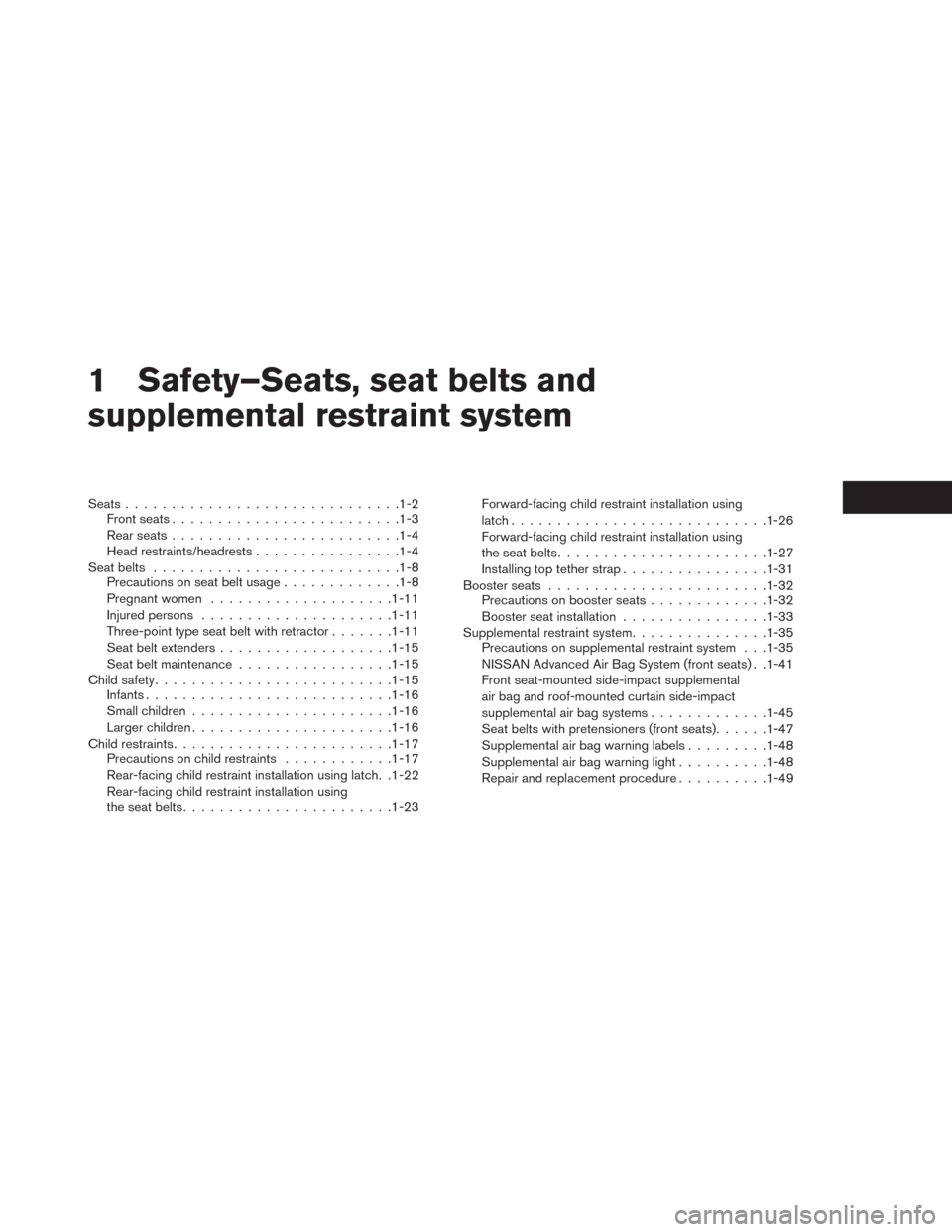
1 Safety–Seats, seat belts and
supplemental restraint system
Seats..............................1-2
Front seats.........................1-3
Rear seats.........................1-4
Head restraints/headrests................1-4
Seat belts...........................1-8
Precautions on seat belt usage.............1-8
Pregnant women....................1-11
Injured persons.....................1-11
Three-point type seat belt with retractor.......1-11
Seat belt extenders...................1-15
Seat belt maintenance.................1-15
Child safety..........................1-15
Infants...........................1-16
Small children......................1-16
Larger children......................1-16
Child restraints........................1-17
Precautions on child restraints............1-17
Rear-facing child restraint installation using latch. .1-22
Rear-facing child restraint installation using
the seat belts.......................1-23Forward-facing child restraint installation using
latch............................1-26
Forward-facing child restraint installation using
the seat belts.......................1-27
Installing top tether strap................1-31
Booster seats........................1-32
Precautions on booster seats.............1-32
Booster seat installation................1-33
Supplemental restraint system...............1-35
Precautions on supplemental restraint system . . .1-35
NISSAN Advanced Air Bag System (front seats) . .1-41
Front seat-mounted side-impact supplemental
air bag and roof-mounted curtain side-impact
supplemental air bag systems.............1-45
Seat belts with pretensioners (front seats)......1-47
Supplemental air bag warning labels.........1-48
Supplemental air bag warning light..........1-48
Repair and replacement procedure..........1-49
Page 102 of 397

There are three basic types of child restraint
systems:
• Rear-facing child restraint
• Forward-facing child restraint
• Booster seat
The proper restraint depends on the child’s size.
Generally, infants up to about 1 year and less
than 20 lb (9 kg) should be placed in rear-facing
child restraints. Forward-facing child restraints
are available for children who outgrow rear-
facing child restraints and are at least 1 year old.
Booster seats are used to help position a vehicle
lap/shoulder belt on a child who can no longer
use a forward-facing child restraint.
WARNING
Infants and children need special protec-
tion. The vehicle’s seat belts may not fit
them properly. The shoulder belt may
come too close to the face or neck. The
lap belt may not fit over their small hip
bones. In an accident, an improperly fit-
ting seat belt could cause serious or fatal
injury. Always use appropriate child re-
straints.All U.S. states and Canadian provinces or territo-
ries require the use of approved child restraints
for infants and small children. See “Child re-
straints”.
A child restraint may be secured in the vehicle by
using either the LATCH (Lower Anchor and Teth-
ers for Children) system or with the vehicle seat
belt. For more information, see “Child restraints”.
NISSAN recommends that all pre-teens
and children be restrained in the rear seat.
According to accident statistics, children
are safer when properly restrained in the
rear seat than in the front seat.
This is especially important because your
vehicle has a supplemental restraint sys-
tem (air bag system) for the front passen-
ger. See “Supplemental restraint system”.
INFANTS
Infants up to at least 1 year old should be placed
in a rear-facing child restraint. NISSAN recom-
mends that infants be placed in child restraints
that comply with Federal Motor Vehicle Safety
Standards or Canadian Motor Vehicle Safety
Standards. You should choose a child restraint
that fits your vehicle and always follow the manu-
facturer’s instructions for installation and use.
SMALL CHILDREN
Children that are over 1 year old and weigh at
least 20 lbs (9 kg) should remain in a rear-facing
child restraint as long as possible up to the height
or weight limit of the child restraint. Children who
outgrow the height or weight limit of the rear-
facing child restraint and are at least 1 year old
should be secured in a forward-facing child re-
straint with a harness. Refer to the manufactur-
er’s instructions for minimum and maximum
weight and height recommendations. NISSAN
recommends that small children be placed in
child restraints that comply with Federal Motor
Vehicle Safety Standards or Canadian Motor Ve-
hicle Safety Standards. You should choose a
child restraint that fits your vehicle and always
follow the manufacturer’s instructions for instal-
lation and use.
LARGER CHILDREN
Children should remain in a forward-facing child
restraint with a harness until they reach the maxi-
mum height or weight limit allowed by the child
restraint manufacturer.
Once a child outgrows the height or weight limit
of the harness-equipped forward-facing child re-
straint, NISSAN recommends that the child be
1-16Safety–Seats, seat belts and supplemental restraint system
Page 104 of 397
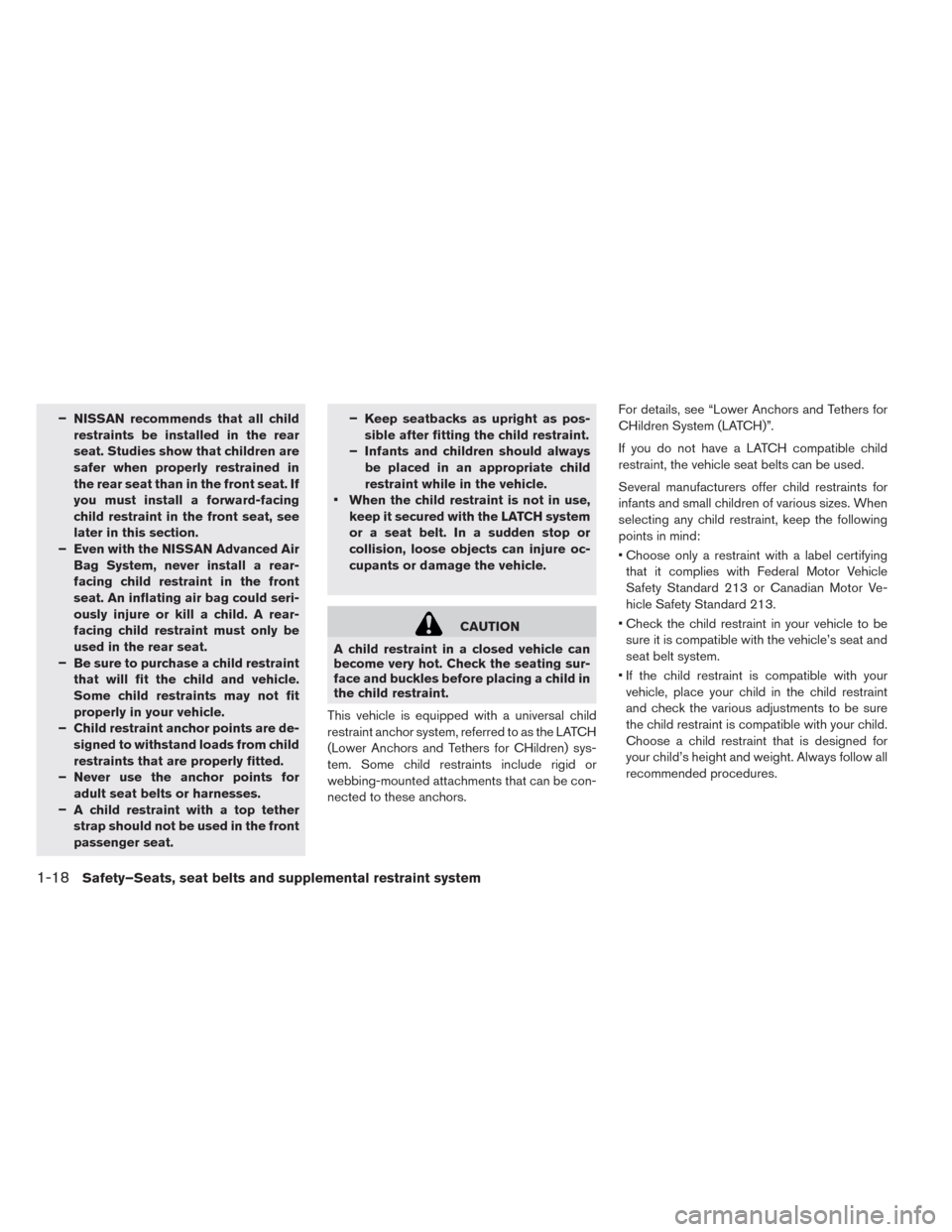
–
NISSAN recommends that all child
restraints be installed in the rear
seat. Studies show that children are
safer when properly restrained in
the rear seat than in the front seat. If
you must install a forward-facing
child restraint in the front seat, see
later in this section.
–
Even with the NISSAN Advanced Air
Bag System, never install a rear-
facing child restraint in the front
seat. An inflating air bag could seri-
ously injure or kill a child. A rear-
facing child restraint must only be
used in the rear seat.
–
Be sure to purchase a child restraint
that will fit the child and vehicle.
Some child restraints may not fit
properly in your vehicle.
–
Child restraint anchor points are de-
signed to withstand loads from child
restraints that are properly fitted.
–
Never use the anchor points for
adult seat belts or harnesses.
–
A child restraint with a top tether
strap should not be used in the front
passenger seat.–
Keep seatbacks as upright as pos-
sible after fitting the child restraint.
–
Infants and children should always
be placed in an appropriate child
restraint while in the vehicle.
•
When the child restraint is not in use,
keep it secured with the LATCH system
or a seat belt. In a sudden stop or
collision, loose objects can injure oc-
cupants or damage the vehicle.
CAUTION
A child restraint in a closed vehicle can
become very hot. Check the seating sur-
face and buckles before placing a child in
the child restraint.
This vehicle is equipped with a universal child
restraint anchor system, referred to as the LATCH
(Lower Anchors and Tethers for CHildren) sys-
tem. Some child restraints include rigid or
webbing-mounted attachments that can be con-
nected to these anchors.For details, see “Lower Anchors and Tethers for
CHildren System (LATCH)”.
If you do not have a LATCH compatible child
restraint, the vehicle seat belts can be used.
Several manufacturers offer child restraints for
infants and small children of various sizes. When
selecting any child restraint, keep the following
points in mind:
• Choose only a restraint with a label certifying
that it complies with Federal Motor Vehicle
Safety Standard 213 or Canadian Motor Ve-
hicle Safety Standard 213.
• Check the child restraint in your vehicle to be
sure it is compatible with the vehicle’s seat and
seat belt system.
• If the child restraint is compatible with your
vehicle, place your child in the child restraint
and check the various adjustments to be sure
the child restraint is compatible with your child.
Choose a child restraint that is designed for
your child’s height and weight. Always follow all
recommended procedures.
1-18Safety–Seats, seat belts and supplemental restraint system
Page 108 of 397
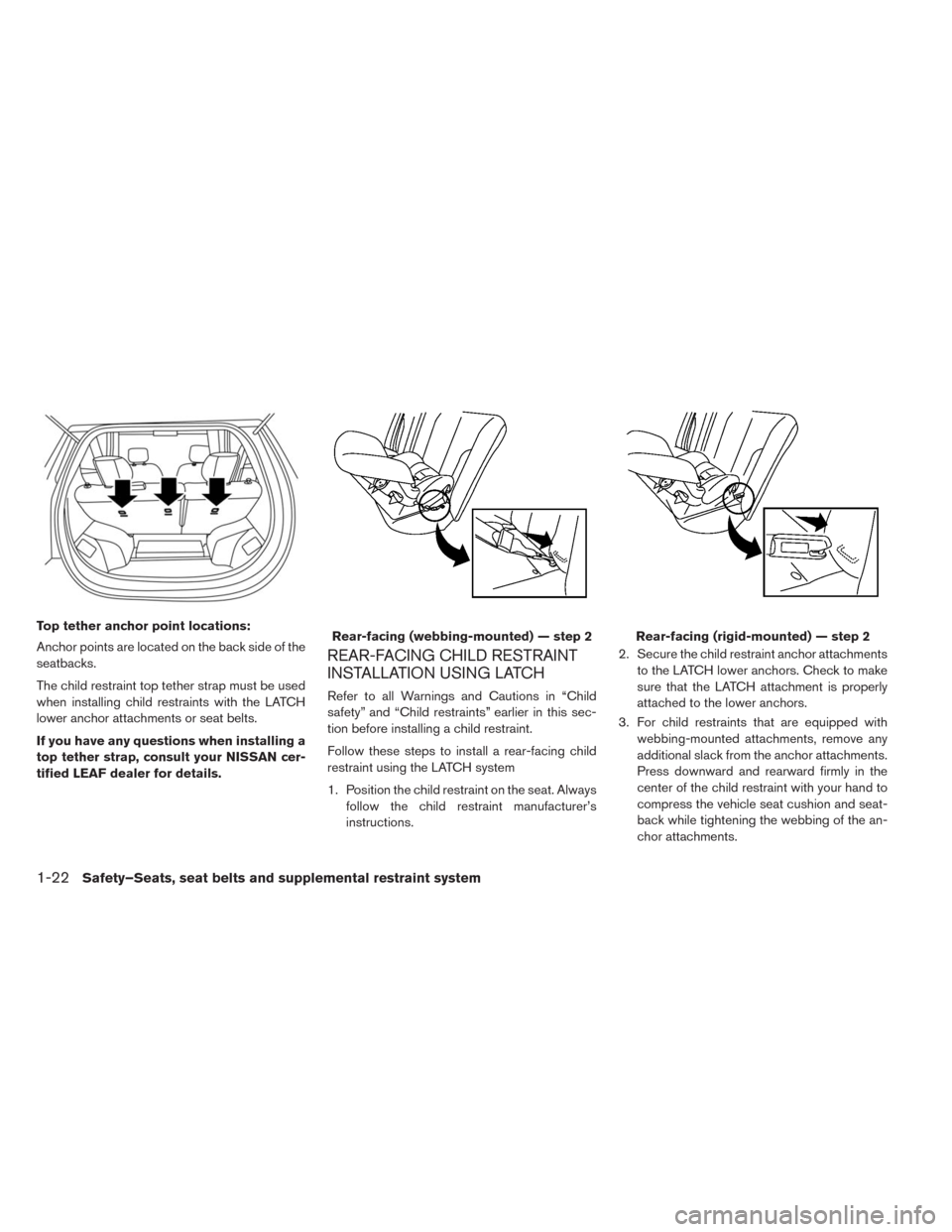
Top tether anchor point locations:
Anchor points are located on the back side of the
seatbacks.
The child restraint top tether strap must be used
when installing child restraints with the LATCH
lower anchor attachments or seat belts.
If you have any questions when installing a
top tether strap, consult your NISSAN cer-
tified LEAF dealer for details.
REAR-FACING CHILD RESTRAINT
INSTALLATION USING LATCH
Refer to all Warnings and Cautions in “Child
safety” and “Child restraints” earlier in this sec-
tion before installing a child restraint.
Follow these steps to install a rear-facing child
restraint using the LATCH system
1. Position the child restraint on the seat. Always
follow the child restraint manufacturer’s
instructions.2. Secure the child restraint anchor attachments
to the LATCH lower anchors. Check to make
sure that the LATCH attachment is properly
attached to the lower anchors.
3. For child restraints that are equipped with
webbing-mounted attachments, remove any
additional slack from the anchor attachments.
Press downward and rearward firmly in the
center of the child restraint with your hand to
compress the vehicle seat cushion and seat-
back while tightening the webbing of the an-
chor attachments.
Rear-facing (webbing-mounted) — step 2Rear-facing (rigid-mounted) — step 2
1-22Safety–Seats, seat belts and supplemental restraint system
Page 109 of 397
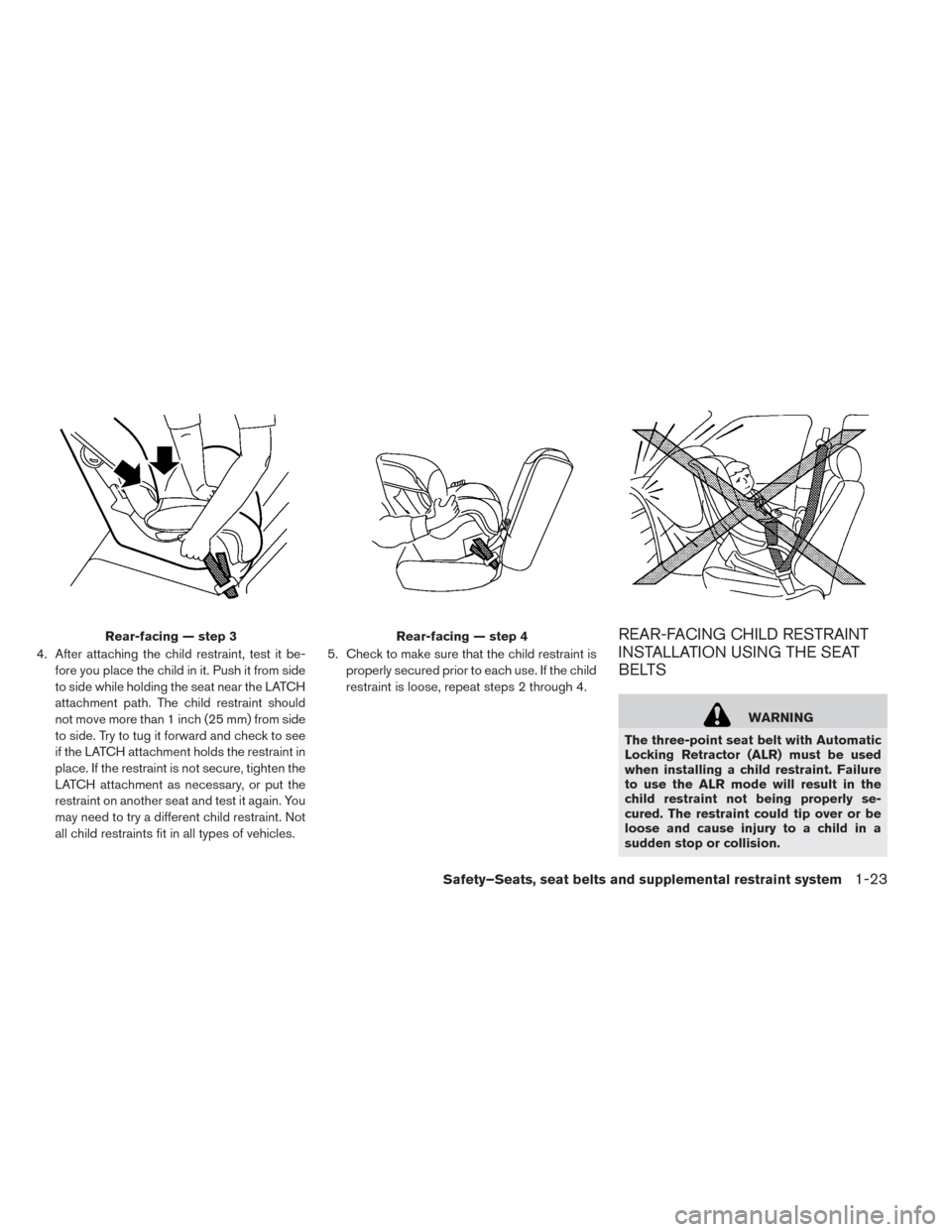
4. After attaching the child restraint, test it be-
fore you place the child in it. Push it from side
to side while holding the seat near the LATCH
attachment path. The child restraint should
not move more than 1 inch (25 mm) from side
to side. Try to tug it forward and check to see
if the LATCH attachment holds the restraint in
place. If the restraint is not secure, tighten the
LATCH attachment as necessary, or put the
restraint on another seat and test it again. You
may need to try a different child restraint. Not
all child restraints fit in all types of vehicles.5. Check to make sure that the child restraint is
properly secured prior to each use. If the child
restraint is loose, repeat steps 2 through 4.
REAR-FACING CHILD RESTRAINT
INSTALLATION USING THE SEAT
BELTS
WARNING
The three-point seat belt with Automatic
Locking Retractor (ALR) must be used
when installing a child restraint. Failure
to use the ALR mode will result in the
child restraint not being properly se-
cured. The restraint could tip over or be
loose and cause injury to a child in a
sudden stop or collision.
Rear-facing — step 3Rear-facing — step 4
Safety–Seats, seat belts and supplemental restraint system1-23
Page 110 of 397

Refer to all Warnings and Cautions in “Child
safety” and “Child restraints” earlier in this sec-
tion before installing a child restraint.
Follow these steps to install a rear-facing child
restraint using the vehicle seat belt in the rear
seat:
1.Child restraints for infants must be used
in the rear-facing direction and there-
fore must not be used in the front seat.
Position the child restraint on the seat. Always
follow the restraint manufacturer’s instruc-
tions.2. Route the seat belt tongue through the child
restraint and insert it into the buckle until you
hear and feel the latch engage. Be sure to
follow the child restraint manufacturer’s in-
structions for belt routing.3. Pull the shoulder belt until the belt is fully
extended. At this time, the seat belt retractor
is in the Automatic Locking Retractor (ALR)
mode (child restraint mode) . It reverts to the
Emergency Locking Retractor (ELR) mode
when the seat belt is fully retracted.
4. Allow the seat belt to retract. Pull up on the
shoulder belt to remove any slack in the belt.
5. Remove any additional slack from the child
restraint. Press downward and rearward firmly
in the center of the child restraint with your
hand to compress the vehicle seat cushion
and seatback while pulling up on the seat belt.
Rear facing - step 1Rear-facing — step 2Rear-facing — step 3
1-24Safety–Seats, seat belts and supplemental restraint system
Page 111 of 397
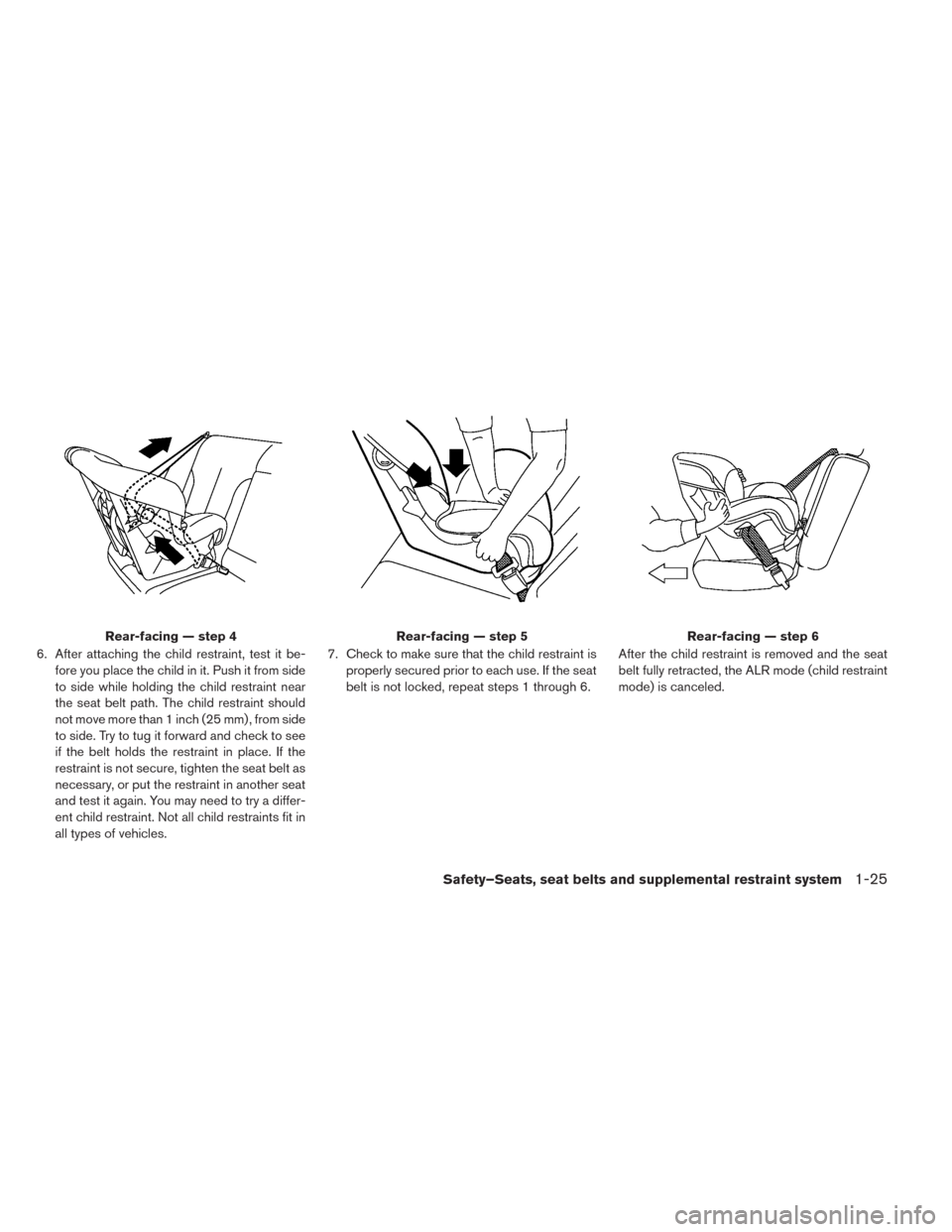
6. After attaching the child restraint, test it be-
fore you place the child in it. Push it from side
to side while holding the child restraint near
the seat belt path. The child restraint should
not move more than 1 inch (25 mm) , from side
to side. Try to tug it forward and check to see
if the belt holds the restraint in place. If the
restraint is not secure, tighten the seat belt as
necessary, or put the restraint in another seat
and test it again. You may need to try a differ-
ent child restraint. Not all child restraints fit in
all types of vehicles.7. Check to make sure that the child restraint is
properly secured prior to each use. If the seat
belt is not locked, repeat steps 1 through 6.After the child restraint is removed and the seat
belt fully retracted, the ALR mode (child restraint
mode) is canceled.
Rear-facing — step 4Rear-facing — step 5Rear-facing — step 6
Safety–Seats, seat belts and supplemental restraint system1-25
Page 112 of 397

FORWARD-FACING CHILD
RESTRAINT INSTALLATION USING
LATCH
Refer to all Warnings and Cautions in “Child
safety” and “Child restraints” earlier in this sec-
tion before installing a child restraint.
Follow these steps to install a forward-facing
child restraint using the LATCH system.
1. Position the child restraint on the seat. Always
follow the child restraint manufacturer’s
instructions.2. Secure the child restraint anchor attachments
to the LATCH lower anchors. Check to make
sure that the LATCH attachment is properly
attached to the lower anchors.
If the child restraint is equipped with a top
tether strap, route the top tether strap and
secure the tether strap to the tether anchor
point. See “Installing top tether strap”. Do not
install child restraints that require the use of a
top tether strap in seating positions that do not
have a top tether anchor.3. The back of the child restraint should be se-
cured against the seatback.
If necessary, remove the head restraint/
headrest to obtain the correct child restraint
fit. If the head restraint/headrest is removed,
store it in a secure place.Be sure to reinstall
the head restraint/headrest when the
child restraint is removed. See “Adjust” for
headrest adjustment information.
If the seating position does not have an adjust-
able head restraint/headrest and it is interfer-
ing with the proper child restraint fit, try an-
other seating position or a different child
restraint.
4. For child restraints that are equipped with
webbing-mounted attachments, remove any
additional slack from the anchor attachments.
Press downward and rearward firmly in the
center of the child restraint with your knee to
compress the vehicle seat cushion and seat-
back while tightening the webbing of the an-
chor attachments.
5. Tighten the tether strap according to the
manufacturer’s instructions to remove any
slack.
Forward-facing (webbing-mounted) —
step 2Forward-facing (rigid-mounted) — step 2
1-26Safety–Seats, seat belts and supplemental restraint system